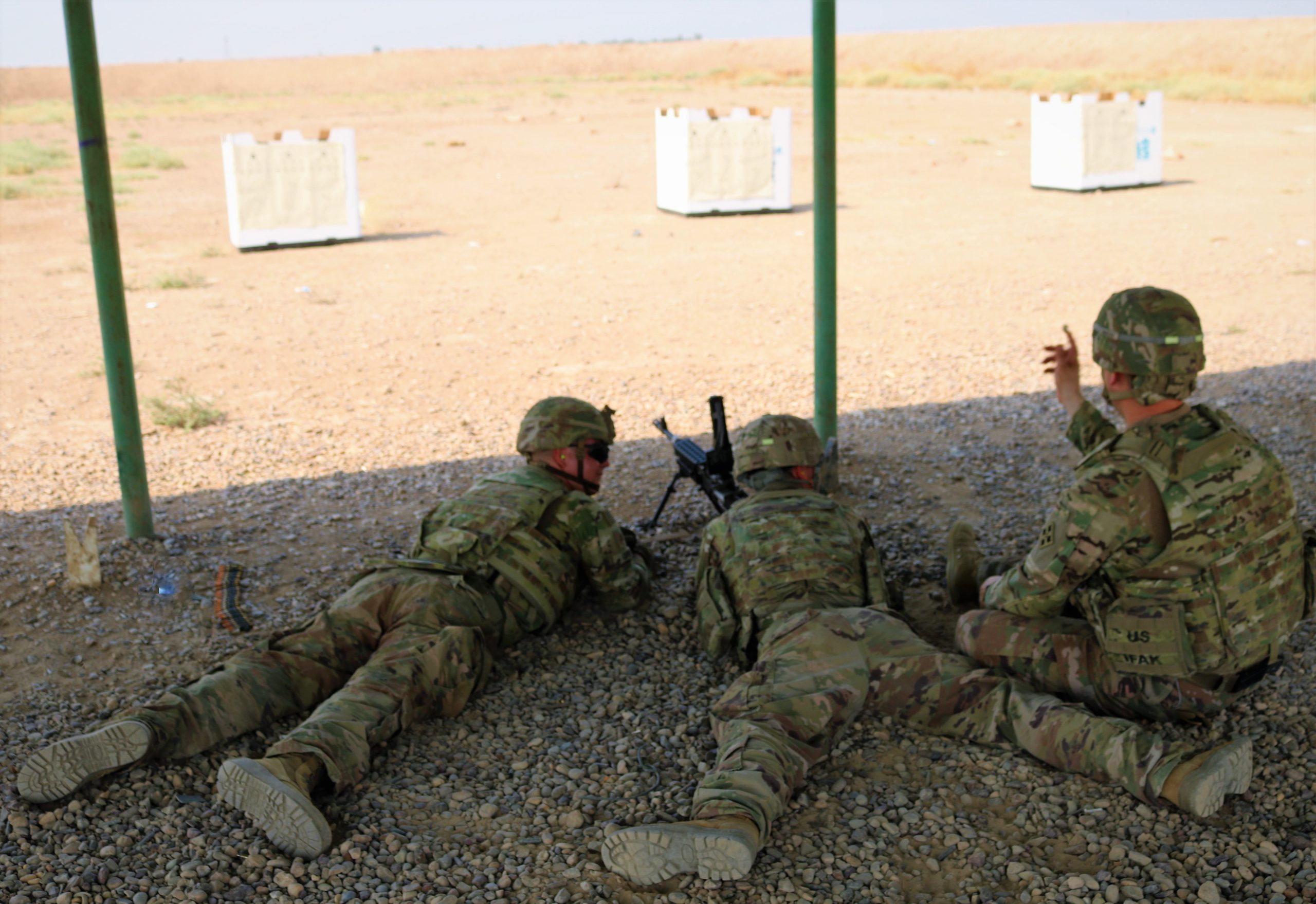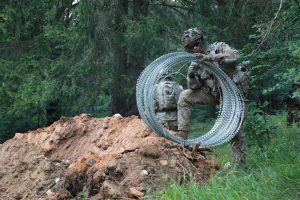Planning and Running a Range + Range Checklist

At the Center for Junior Officers (CJO), we work to deliver content where leaders can best consume it. One of the experiments we’ve tried this past year is producing instructional videos on aspects of the military profession. The videos are available only to members of CJO registered to the site. But blog content is accessible to everyone. So, to accompany some of our videos, we’ve written blog posts to preview that content. This blog post delivers much of the content available in our Range Best Practices video.
One of the most common missions new junior leaders struggle to perform effectively is the qualification range. A range is a significant allocation of resources – time, personnel, equipment – treat them accordingly. One of the best ways to shine as a leader is to run an excellent range. However, most ranges you’ll complete in your career will be minimally effective, replete with hurry-up-and-wait, and negligible training value. This paper and the supported video and reference content will help you avoid that common pitfall.
Treat every range as a prime training opportunity. Not just to increase the number of qualified Soldiers but to increase the proficiency of combat skills and leadership. An excellent range takes time, planning, and engaged leadership. Squeezing the most training out of allocated resources is one of the key factors that sets good leaders apart at every level – but especially at company-grade. Here’s a four-step process, and five essential tips, to help execute an excellent range.
Step One, take a look at the training schedule and lock in your range time. A well-run range takes advantage of the 8-step training model and utilizes the full T-week allocation. Sometimes you’ll have to move faster – but that means completing the steps more quickly, not skipping over them. Locking in your range time first, nested within your unit training schedule, allows you to backwards plan every other action. The 8-step training model gives you the blueprint for how that plan must develop.
The 8-step training model consists of 1. Plan, 2. Train the Trainers, 3. Recon the Site, 4. Issue Order, 5. Rehearse, 6. Execute, 7. Evaluate the Training, and 8. Retrain. The 8-step training model roughly coincides with the Army Troop Leading Procedures (TLP). The Army T-week model provides a framework for synchronizing and institutionalizing the 8-step model within the Army training schedule. The T-week model is detailed in FM 7-0 in Annex H.
Step Two, utilize unit continuity files. Your unit should have a range Standard Operating Procedure (SOP), Operations Orders (OPORD) and Concept of the Operations (CONOP) from previous ranges, and other members of the unit with experience. There’s nothing wrong with building off the work of others. There is something wrong with blindly copying someone else. Copying leads to a lack of understanding, ownership, and accountability. You’ll often see it in ill-disciplined units and leaders. They copy mistakes, build little knowledge in individuals and teams, and it shows. A good spot-check can almost always find the tell-tale signs of leaders who copy others’ work without understanding or taking ownership.
Step three, backwards plan into the T week cycle of the training schedule. The T-week model follows the 8-step training model, as found in FM 7-0 and a Leaders Guide to Unit Training Management (available on ATN). T-8: Execute Reconnaissance and lock in resources. T-7: Publish OPORD for training event. T-6: Lock in training; publish training schedules. T-5: Complete tactical plan and supporting products. T-4: Conduct certifications and complete prerequisite training. T-3: Conduct rehearsals. T-2: Finalize administrative support requirements and conduct OPFOR rehearsal. T-1 Draw equipment and supplies and execute subordinate rehearsals and checks. T-week: Execute training. T+1: Recover, conduct final AARs, and assess training.
The T-week cycle is an incredible template and guide – but sometimes timelines can be shortened or lengthened depending on factors outside your control. If you get more time, excellent, if not, you’ll need to move through the steps more quickly. If you understand the 8-step and T-week model by using them repeatedly, you’ll find truncating the process much more comfortable.
Hopefully, you reserved your range with range control and on higher’s training calendar immediately after receipt of mission. A great technique is to reserve a primary and an alternate location. Depending on your training site, higher-priority units can sometimes bump your training, adverse weather can cause delays, or a host of other problems can arise. Having a primary and alternate range increases your chances of executing the range at the time allotted.
Frequently you’ll need to request ammunition soon after locking in your range time. Range schedules and ammunition allocations tend to be the things your unit has the least control over – so get them done first to meet the timelines of the elements controlling those resources. The S-3 at battalion and above will have expertise and authority to assist with ammunition procurement. Note ammunition generally comes with transportation and handling restrictions that will require personnel with special certifications – all of which take time and effort to coordinate, so include them in your plan.
Step Four. Write and issue your OPORD. Some units may use CONOPs – which is a technique graphically depicting the core of the OPORD. A CONOP is a great way to communicate essential information in an order in a concise manner. A CONOP is a useful addition to an OPORD – not a replacement. Write a full OPORD and issue it – the detailed work will save you time and headaches throughout preparation and execution.
The OPORD is the most copied aspect of training in most units. It’s great to improve upon the work of others – but make sure you understand your order thoroughly and are communicating clearly and comprehensively. There are few things more destructive to your plan than having people execute incorrectly due to sloppy cut & paste. The OPORD should cover your plan, preparation, and execution. GTA 7-1-30 has a great checklist, and we’ve included some sample OPORDs and OPORDs checklists in the supporting documents.
A good range OPORD covers range details (i.e., firing order, DTG, location), remedial training, uniform requirements, PMI requirements, risk management, medical support, transportation, supplies, rehearsal, range close out report, and AAR. An excellent range OPORD will also include concurrent training and multi-phase PMI.
The rest of the steps are just following the OPORD you’ve laid out. But, there are a few techniques you can include in your plan and execute to maximize the effectiveness of your range.
1, invest in an effective multi-phase Primary Marksmanship Instruction (PMI). Classroom instruction is just one part of PMI. Individual and group drills, like the dime and washer drill, shadowbox, and quick-reaction/quick-reload, are useful skill-builders and offer the chance to identify weak shooters or shooters with bad habits/poor fundamentals. Virtual training simulators, like the Engagement Skills Trainer (EST), are an exceptional tool when incorporated into a good PMI. Utilizing virtual and constructive tools in PMI should be a way to build skills and identify coaches for the range – along with those in need of coaching. PMI should continue through range execution. If a Soldier has trouble qualifying, demonstrates weak fundamentals or skills have the mechanism to pull them off the firing line and work on their issues before putting them back on the line. The goal of a range – as with any training – is to increase the skills and lethality of our force. Qualification is a measure of skill – not the end itself.
2, incorporate concurrent training. Any range requires transport to/from the range and will rarely accommodate the entire training audience on the firing line at one time. That means, depending on the length of travel to/from the range and number of firers/capacity of the firing line, there can be substantial ‘sitting around’ for the training audience. That’s prime training time with a captive training audience – take advantage of it! Transport to/from the range offers an excellent opportunity for lecture and question/answer style training. The range itself should be able to accommodate a variety of training activities – as long as safety is maintained. Additional PMI is an obvious choice but with just a little further planning and effort ranges, provide an excellent opportunity to set up small STX lanes or CTT events. Depending on the training audience, this ‘hip-pocket’ training is an opportunity to assign training tasks to junior leaders and increase their leadership proficiency along with Soldier skills.
3, After Action Review (AAR). Too often, the AAR is Pro-forma and fails to teach the self-critical, continually improving organization we all want to be a part. Make sure you allocate the right amount of time and effort to fully capture what went right and what went wrong to improve future training. The AAR is the natural partner of step two mentioned above. Think about what you went through ‘looking at what came before’ when executing the AAR. The AAR should be oriented on that next range by your replacement. A mark of truly great company and field-grade leaders is their ability to set successors up for success.
4, Remedial Training. If everyone meets or exceeds the training standard, the training was not challenging enough. The standard should remain the same – but by varying, the conditions training can be extremely challenging. Factor in the need for some – if not all – Soldiers to require a review of supporting individual skills.
5, Recovery. Maintaining equipment and accountability are core skills for Soldiers and leaders. Utilize the opportunity range recovery provides to reinforce maintenance and accountability procedures and training within your formation.
Here’s a sample vignette demonstrating the steps and tips we’ve discussed.
LT Marshall is assigned as the range OIC for a company small arms range next quarter. The mission is to qualify Soldiers on their assigned weapons in order to increase company readiness statistics. LT Marshall understands the assigned mission but wants to improve overall proficiency as a part of qualification.
He immediately looks at the company training schedule and identifies a date and locks it on the calendar. He identifies his NCOIC and essential support by talking to the training NCO and the battalion S-3. His BN typically uses the same qualification range on Camp Bullis, but the S-3 tells him the range runs into frequent shut-downs for visibility due to it’s proximity to San Antonio airport in the spring when he has to run his range – plus range control only allows you to reserve a single range, no alternates.
So, instead of the standard range, LT Marshall utilizes BN S-3 to help him request two range sites on a TXANG range about an hour north of the city. They have plenty of range space – though you’re vulnerable to being bumped for higher priorities. So, he makes sure to request two ranges – a primary and an alternate. Range control at the site lets him know that’s fine and they have a procedure for prioritizing.
With the range booked, he knows ammunition and transportation will require the longest lead time. He works with the S-3 to put his requests immediately – with room to adjust as he refines the plan.
Now he sits down with his NCOIC to sketch a concept and backwards plan. He’s got the continuity files for previous ranges and especially the AARs, which provide him best practices others have used. He and his NCOIC decide they’re going to layer concurrent training, PMI, and leader development throughout the range.
LT Marshall decides to certify range cadre early, to leverage them throughout the PMI process. All Soldiers will receive classroom instruction from certified leaders at the platoon and squad level. They will come together for the EST 2000 as the PMI certifying event. Platoons are given the task to conduct conditioning road marches to be ready for the EST. The EST will be a company training event. The company will conduct a tactical road march with full gear to the EST. Once there, they will rotate by squad through the EST with range cadre on hand to identify weak firers and coaching categories. As squads rotate through the EST the remaining company, by squads, will rotate through dime and washer drill, shadowbox drill, quick-fire drill, magazine change drill, and IMT stations. Certified PMI instructors will cover each station to identify poor fundamentals or weak firers for additional training before the range.
Soldiers will travel by bus to the range and participate in an LPD on both legs. On the way up, they’ll watch an episode of ‘Band of Brothers’ with discussion questions at the start and finish of the episode from the company 1SG. On the way back, they’ll discuss the questions.
Once at the range, Soldiers will receive a safety brief, draw weapons, then divide by squad to rotate through the firing line and conduct concurrent training. One squad at a time will be on the firing line, one in the waiting area receiving the range brief and safety check, while the rest will rotate through concurrent training stations. The concurrent stations will focus on CTT skills with a call for fire station, 9-line medevac station, two first aid stations, and a react to contact station. Once a squad certifies at all stations and all members are qualified, they can move to the alternate range and go through an STX lane set up to test the individual skills together in a scenario.
Soldiers who fail to qualify the first time will be pulled off the firing line and go through additional PMI and coaching. Their second time through the firing line, they’ll be accompanied by a coach. Soldiers who fail to qualify a second time will be identified for retraining and rejoin their squad for concurrent training.
Soldiers will conduct a brief cleaning at the close of range operations before turning in weapons. Weapons will be transported back and go through the immersion tank before being redrawn for cleaning and quarterly maintenance. The AAR will take place the day after the range to facilitate recovery.
With a clear concept and backwards plan, the OIC and NCOIC can write and publish the order – directing and resourcing the plan they’ve made. When writing the order, they take particular care with the composite risk assessment. Leaders must always manage risk and few things are more dangerous than live ammunition. LT Marshall resists the common mistake of copying the last risk assessment without looking at it. He and his NCOIC carefully go through every risk and the mitigations. They then ensure the mitigations are written into the order. They then have the company commander and 1SG review the mitigations – putting them through tough questioning and murder-boarding their plan. Once that is complete, the OIC and NCOIC further refine the mitigations and update the plan.
After the range, LT Marshall holds an AAR with the cadre, support staff, and key leaders, including the S-3, company commander, and 1SG. All-in-all it was a great training event and fit well into the broader training plan. But, the AAR identified several issues. Several personnel from throughout the BN participated in the range to ‘get qualified’ but had not gone through the PMI and didn’t fit into the concurrent training rotation. Amongst this group were several senior leaders from the BN staff, who traveled out separately and participated in none of the concurrent training. Leaders complained about not all Soldiers getting qualified and many Soldiers not being able to ‘up their score’ since Soldiers got so few rotations on the firing line. Some leaders felt that despite mitigations, it was a safety issue for Soldiers to have rotated through concurrent training with the same weapons they used on the firing line.
LT Marshall made sure to note all these issues and sat down with key leaders afterward to work on fixes to improve for the future. The BN S-3 agreed to ensure any future range orders would be BN orders – even if a company were executing them. PMI, transportation, and concurrent training would be required and no one would be allowed on the range who didn’t adhere. Future orders would ensure there were omega squads to encompass staff and eaches. They would look at bringing rubber duckies to ensure live weapons stayed on the range while Soldiers had a simulator to use in concurrent training. Future iterations would look at factoring in later rotations of firers for improved scores but they decided to keep the practice of limiting Soldiers that did not qualify. There was no reason to waste ammunition before a Soldier had mastered the fundamentals of marksmanship. As good as this range was – the next one was going to be even better.
Check out this other CJO resource – General Range Checklist
General Range Checklist – The Center for Junior Officers (army.mil)
———
LTC Charles D. Hood is a military intelligence officer who has served in a variety of strategic and tactical assignments, including 2ID, 101st ABN DIV (AASLT), SHAPE, NSA, JSOC, DIA, 10th MTN DIV (LI), and INSCOM. He holds a BA in History from UNC Asheville and an MA in Political Science from Baylor University.
Related Posts

Going Off Script, But Staying on Track: A Career Guide for Junior Leaders
Intro I walked into LTC Tomi King’s office as a new 2LT in his formation. We discussed all the normal talking points in that initial counseling – family, where I …

Fighting as an Enabler Leader
(U.S. Army Photo by Cpl. Tomarius Roberts, courtesy of DVIDS)Enablers provide capabilities to commanders that they either do not have on their own or do not have in sufficient quantity …

Defeating the Drone – From JMRC’s “Skynet Platoon”
If you can be seen, you can be killed—and a $7 drone might be all it takes. JMRC’s Skynet Platoon discuss their TTPs to defeat the drone.
